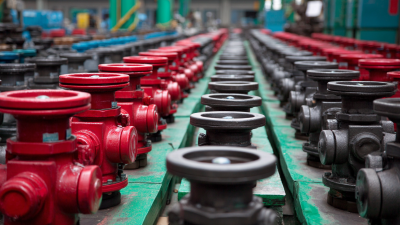
In today's industrial landscape, the efficiency and reliability of fluid monitoring systems are paramount, with flanged sight flow indicators playing a critical role in various applications. According to a recent report by MarketsandMarkets, the global flow indicator market is expected to reach USD 4.2 billion by 2025, driven by increasing demands in oil and gas, chemical, and water treatment industries. These instruments provide visual confirmation of flow conditions, ensuring optimal performance and safety in processes. However, selecting the right flanged sight flow indicator can be daunting given the myriad of options available. Factors such as pressure ratings, material compatibility, and design configurations must be carefully considered to ensure that the chosen indicator is not only effective but also tailored to the specific needs of the application at hand. This ultimate guide aims to simplify the selection process, empowering engineers and decision-makers to make informed choices.

When selecting flanged sight flow indicators, it's essential to consider the specific requirements of your industry. Different sectors, such as chemical processing, water treatment, and food and beverage, can impose varying demands on flow indicators. For instance, in the chemical industry, the indicator must withstand corrosive materials and high-pressure conditions, while in the food and beverage sector, sanitary standards dictate the need for materials that are easy to clean and resistant to bacterial growth.
 Understanding these industry-specific criteria will aid in choosing the most suitable indicator for your application.
Understanding these industry-specific criteria will aid in choosing the most suitable indicator for your application.
Another crucial consideration is the size and compatibility of the flanged sight flow indicator with existing piping systems. Proper sizing ensures optimal flow visibility and accuracy in monitoring. Additionally, one must also evaluate the installation environment; indicators exposed to extreme temperatures may require specialized materials or designs to ensure functionality and longevity. Assessing these factors, along with the flow media characteristics, will help ensure that your selected flanged sight flow indicator performs reliably and effectively in your specific operational context.
In industrial applications, flow visibility is paramount for ensuring both efficiency and safety. The right flanged sight flow indicator allows operators to monitor fluid movement in real-time, providing critical data for optimizing processes. Without proper flow visibility, systems can face operational inefficiencies and increased risks, making it essential to choose indicators that are well-suited for specific applications.
To select the best flow indicator, consider the following tips: First, assess the specific requirements of your application, including the type of fluid, flow rate, and temperature. Second, evaluate the materials used in the construction of the flow indicator to ensure compatibility with the fluids being monitored. Lastly, think about the installation and maintenance aspects, as easy-to-install components can save time and reduce downtime in operations.
Understanding the significance of flow visibility extends beyond individual operations. In sectors such as aerospace and defense, where supply chain visibility is crucial to national security, having reliable flow indicators in your processes can help mitigate risks and enhance overall operational integrity. Prioritizing flow visibility supports not only operational excellence but also strategic advantage in competitive markets.
| Feature | Description | Applications | Material | Size Range |
|---|---|---|---|---|
| Transparency | Clear visibility of flow direction and flow rate | Chemical processing, water treatment | Glass, Acrylic | 1" to 12" |
| Pressure Rating | Maximum operating pressure supported | Oil and gas, HVAC systems | Stainless Steel, PVC | 150 psi to 3000 psi |
| Temperature Range | Temperature limits for operation | Food processing, Pharmaceutical | Borosilicate Glass, High Temp Plastics | -40°F to 400°F |
| Installation | Ease of installation and direction of flow indication | Water supply, Fire protection systems | Mild Steel, ABS | 2" to 10" |
When selecting a flanged sight flow indicator, material compatibility is critical to ensure optimal performance and longevity. Different fluids can react with specific materials, leading to degradation or failure of the indicator. According to a recent industry report by the Flow Measurement Institute, over 30% of flow indicator failures are attributed to inappropriate material selection.
For instance, stainless steel is often chosen for its corrosion resistance with water and oil-based fluids, while polycarbonate may be more suitable for less aggressive solutions.
To determine the right construction for your application, it's essential to consider the chemical properties of the fluids involved. The Chemical Safety Data Sheet (CSDS) for your specific application can provide vital information about potential interactions with materials such as glass, acrylic, or various metallic alloys. For instance, while acrylic provides good visibility and is lighter, it can be susceptible to certain solvents, making it less suitable in those scenarios. A thorough analysis of these factors not only enhances the effectiveness of the sight flow indicator but can significantly reduce operational costs and prevent costly downtimes.
When it comes to flow rate measurement accuracy, choosing the right flanged sight flow indicator is crucial for achieving reliable results in various industrial applications. According to a report by the International Society of Automation (ISA), flow measurement inaccuracies can lead to significant operational inefficiencies, potentially costing industries as much as 2% of their annual revenue due to miscalculations. Therefore, understanding the factors that influence flow measurement accuracy is vital for optimal system performance.

One key aspect to consider is the type of fluid being measured. Different fluids – whether they are liquids or gases, Newtonian or non-Newtonian – can have varying impacts on flow rates. The American Society of Mechanical Engineers (ASME) suggests that flow indicators designed for specific media should be selected according to their compatibility rates and viscosity, ensuring that the indicators function accurately under the given conditions. Additionally, maintaining proper installation alignment and following the recommended placement (usually straight sections of pipeline before and after the indicator) can significantly enhance measurement precision, with studies indicating that poor installation can result in an accuracy drop of up to 30%. Adopting standard practices and leveraging high-quality indicators is fundamental in achieving high measurement accuracy.
When it comes to ensuring optimal performance and longevity of
flanged sight flow indicators, proper installation and maintenance practices are paramount. First, during installation,
it’s crucial to ensure that the flow indicator is mounted in accordance with the manufacturer's specifications,
taking note of flow direction and orientation. Employing appropriate gaskets and ensuring that all bolts are
torqued to the recommended specifications will help create a tight seal, thus preventing leaks.
Additionally, it is essential to avoid any stress on the flange by ensuring that piping is properly aligned
prior to installation.
Maintenance plays a significant role in preserving the functionality of sight flow indicators. Regular inspections
should be conducted to check for signs of wear, corrosion, or buildup that may impair visibility or flow accuracy.
Cleaning the indicator is vital; using non-abrasive materials and suitable solvents
will help maintain clarity without damaging the equipment. Lubricating the moving components, if applicable, will also ensure
smooth operation. By following these best practices, operators can extend the life
of their flanged sight flow indicators and maintain reliable performance in their applications.




